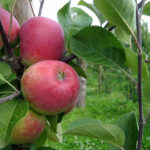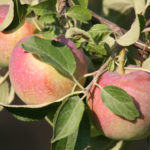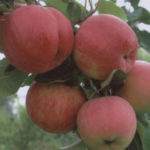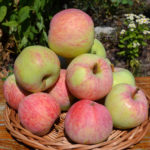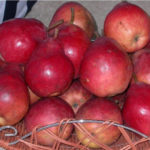Apple variety Quinti
The Quinte apple tree is considered one of the most popular varieties of foreign selection; gardeners appreciate it for its early maturity and excellent taste. But along with the undoubted advantages, the foreigner also has disadvantages. The variety was obtained in Canada by crossing Crimson Beauty and Red Melba... In Russia, it has become widespread since 1986, it was included in the State Register of Breeding Achievements of the Russian Federation in the North Caucasus, the Lower Volga Region and the Central Black Earth Zone. Over the years of cultivation, the variety has become widespread in areas with a temperate and warm climate - Kursk, Voronezh, Rostov, Volgograd, Lipetsk and Astrakhan regions, Krasnodar Territory, the Republics of Kabardino-Balkaria and North Ossetia. But at the moment our hero is absent from the State Register.

Description
The plant is characterized by small size, height - 3 - 4 m. The annual growth of skeletal branches is 5 - 6 cm. The crown is rather rare, wide-rounded with a slight spreading, which is given by the lower drooping branches. The branches that form the skeleton are strong, thick, curved, attached to the trunk almost at right angles, covered with a smooth greenish-gray bark. The bark of the trunk is flaky, light brown in color with a grayish tinge. Shoots slightly curved, not very long, of normal thickness, bark is dark green, on the sunny side it becomes light brown, pubescence is very weak. Shoot-forming ability is moderate. Lentils are light, round or oval, rarely located, but clearly visible. The internodes are of medium length. The foliage is strong. Leaves are dark green, large, often keeled, isosceles, mostly broadly oval, less often ovoid. The apex is broadly wedge-shaped, with a smoothly or sharply tapering tip, the base is wide, the edges are evenly serrated. The pubescence of the underside of the leaf blade is moderately pronounced, less often weak, tomentose. The petiole is long, of normal thickness, slightly pubescent. Stipules not too large, lanceolate. Leaves in relation to the shoot are located at an angle of 60 °, less often 90 °. Fruit formations - ringlets, are mainly located on the wood of the last year. Spear, sometimes fruit twigs form on perennial wood. The flowers are white, mostly large, rarely medium. The pistil is located at the same level with the stamens, strongly pubescent at the base. The kidneys are large, narrow-conical, have medium excitability.
As a rule, the fruits of the Quinti apple tree have an average size, weight 120 - 150 g. But if the harvest is small, then the apples become quite large. In shape, they are round or elongated-conical, almost one-dimensional, with a smooth surface. The funnel is relatively deep and wide. The saucer is shallow, less often of medium depth, narrow, shallow or medium-folded, with noticeable pearls. The cup is of medium size, closed type. The sub-cup tube is large, deep, usually funnel-shaped, less often conical. The heart is bulbous, large, located closer to the base of the fruit. The axial cavity is very large, the open seed chambers are also large. Seeds are large or medium, broadly ovate, brown in color. The peduncle is of medium length and thickness, located at the level of the edges of the funnel, but more often extends beyond its limits.
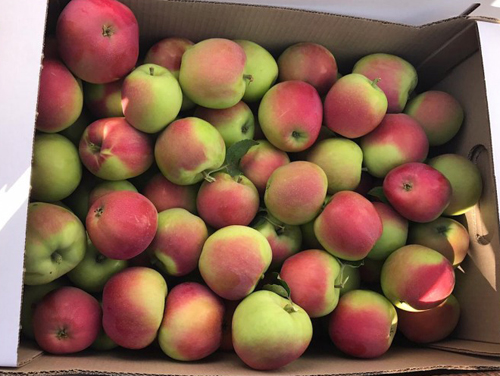
The skin is not thick, elastic, firm, smooth and shiny, has a strong aroma. There is a wax coating, but to a small extent. By the time of ripening, the main color of the fruit is greenish-yellow, the integumentary color in the form of a dark red or orange-red blush with a raspberry tinge occupies most of the fruit or its entire surface. On the dimly lit side, a pattern in the form of intermittent stripes against a background of a faint marble blush or a basic greenish-yellow color can be seen. Subcutaneous punctures are white, sometimes grayish, of medium size, numerous, clearly visible.The pulp is quite dense, fine-grained, juicy, greenish during the ripeness period, in a fully ripe apple it has a pleasant creamy shade. The taste is good, sweet and sour, the aroma is weak. Tasting score 4.3 - 4.6 points. 100 g of fresh pulp contains: dry matter 15.9 - 16.8%, total sugars 10.3 - 11.2%, titrated acids - 0.53 - 0.6%, ascorbic acid 8.4 - 11.2 mg. The ratio of sugar to acid is 21.1 (35.6).
Characteristics
- The beginning of fruiting of the Apple tree Quinti comes in 4 years, which refers our heroine to early-growing varieties. True, on a vigorous seed stock in the southern zone of horticulture, the culture is distinguished by a late entry into the fruiting period - not earlier than 9 years later;
- the tree blooms early, blooms very generously. Pollen vitality is 37 - 52%;
- in terms of ripening, the variety belongs to the summer, many gardeners consider it super-early. In the Lower Volga region, the crop ripens very early - in mid-July. In Ukraine, removable and consumer ripeness in the Steppe begins in the first decade of July, in the conditions of the Forest-steppe - in the second half of July, in Polesie - in the third decade of July. Compared to White bulk, then our hero ripens 4 - 5 days earlier than him;
- some sources mention that the culture has a tendency to periodicity in fruiting. Other sources, such as VNIISPK, describe fruiting as regular;
- productivity is very good. The yield increases from year to year. So, 7 - 8-year-old trees bear 12 - 25 kg of fruits, by 10 - 13 years this figure is already 38 - 60 kg from one tree. According to VNIISPK, the yield is 102 - 120 kg per tree;
- immunity is not high enough. The variety does not resist scab well, which reduces the already insufficient winter hardiness. But at the same time there is a very high resistance to powdery mildew;
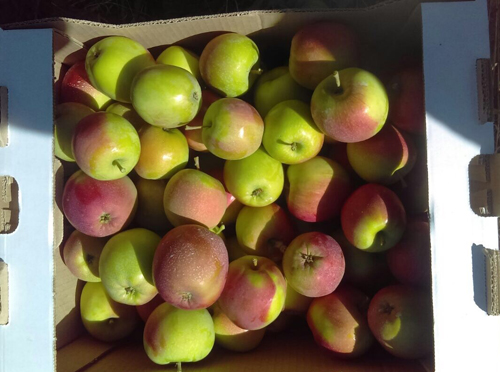
- the culture shows unequal winter hardiness in different regions. So, in the south, resistance to a complex of environmental influences in winter is noted as moderate, but in the middle lane the apple tree winters much worse. True, according to the results of the unfavorable winter of 1997 - 1998 in the Southern zone of horticulture (the North Caucasus and the Lower Volga region), the degree of freezing was 3.0 points;
- the fact that our heroine is more adapted to the conditions of warm regions is evidenced by her good heat resistance, the apple tree is also able to withstand short-term dry periods;
- transportability is average. During transportation, apples often get dents, due to which the already short shelf life is reduced, and the presentation is lost (data from VNIISPK). Other sources describe the portability as high;
- shelf life is very small - about 10 days. According to other sources, the crop can be stored for up to 1 month;
- the way of using the crop is universal. Having eaten plenty of early apples, hurry to process the remaining harvest. It produces high-quality jam, jam, baking stuffing, compote, marmalade.
Pollinators
Apple tree Quinti is self-fertile. To increase the yield and quality of the fruits, it is necessary to have suitable pollinators that bloom with our hero in the early stages. These include: Folding, Julired, Vista Bella, Stark Erliest.
Planting and leaving
Since Quinti is grown mainly in warm regions, the autumn period is suitable for planting, the period is 3 weeks before the onset of stable cold weather. Choose a sunny place. Avoid planting in lowlands and pits, where cold air accumulates, which can negatively affect early flowering. In order for the apple tree to develop in comfortable conditions, the planting scheme should be observed - 4 m between trees in a row, 5 m - row spacing. Our hero is picky about soils, but loose and fertile loams are considered the most suitable for him. Watering should be taken responsibly. Despite the fact that the culture is capable of withstanding dry periods, the soil in the near-trunk circle should be in a moderately moist state.
The care process needs to be adjusted in accordance with the requirements of the apple tree. Given the weak resistance to scab, the spring should be started by treating the crown with copper-containing preparations.Thinning pruning will also be needed, which reduces the thickening, and therefore improves the airflow rate of the crown. Of the fertilizers, phosphorus-potassium fertilizers are preferred, they increase the general immunity of the tree and winter hardiness. In autumn, the trunk circle is insulated with a 15 - 20 cm layer of mulch, and the trunk and skeletal branches are wrapped in any breathable material.
The choice of an apple variety should always be approached responsibly, taking into account the characteristics and characteristics of the culture. The Canadian Quinti apple tree, first of all, is appreciated for its very early ripening, good taste. In regions with warm climates, where summer temperatures rise well above 30 ° C, heat resistance and drought resistance will help the cultivar to survive. But at the same time, our hero has some drawbacks. Abnormally hot temperatures can play a cruel joke with a plant, especially a young one. Having given the harvest early, the apple tree can bloom a second time, of course the fruits will not ripen anymore, but the yield for the next year may decrease. Even in the southern regions, winter hardiness may not be high enough. In addition, a decrease in resistance to unfavorable winter conditions is influenced by scab, to which Quinti has no immunity.
